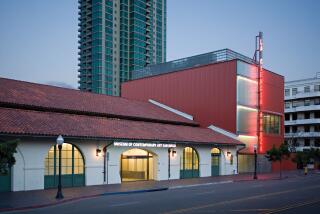Vaulting into car history at the Petersen museum
Chris Brown’s voice is giddy as the elevator in the Petersen Automotive Museum begins its descent to the basement. He is as excited as his visitors, but before the doors open he strikes a tone of caution.
“No touching, no photos and watch your step,” he says. “Old cars are like little dogs: They tend to leave puddles.”
The group chuckles nervously and follows him down a corridor lit by dim fluorescent lights into an enormous cavern filled with hundreds of neatly parked cars.
PHOTOS: Stepping down in time | The Petersen Automotive Museum vault
Brown, 38, is the museum’s marketing director, but today he’s exchanged suit and tie for a black racing jacket with “Petersen Museum” emblazoned in red letters on the back. Like an impresario, he faces his visitors and gestures out over the showroom, a place that has a nearly legendary status among automotive insiders around the world, a place known as the vault.
Taking up a city block on Wilshire Boulevard’s Museum Row, the Petersen has drawn visitors since 1994. Its collection is considered one of the finest in the country, with detailed dioramas and presentations that provide historic and cultural context.
The vault — once restricted to high-ranking museum personnel and visiting VIPs, but now open to the public through Jan. 6 — is far different than the galleries upstairs. Inside, in a space the size of a football field, are 150 cars parked as if in a city lot. There are no special displays with manikins, velvet ropes and faux boulevards.
Many of the cars have been displayed at other times in the museum, but to see them in such simple circumstance is a chance to appreciate the swoop of a fender, the rake of a radiator grille or the grain of a leather interior.
“When you see a car upstairs,” said Jay Leno, who visited the vault before its opening, “it’s all polished up and roped off and everything. For a car guy like me, I prefer to walk up to a car and see it without all the pomp and circumstance.”
Brown begins the hourlong tour following a clockwise pattern. To his right is a black 1952 Ferrari Barchetta once owned by Henry Ford II. Behind him is the burgundy 1953 Cadillac coupe that Prince Aly Khan gave to Rita Hayworth. Herbie the Love Bug is against a far wall.
The tour group huddles in close so as not to miss a word. Stopping before a black Lincoln with undulating front fenders that hang over brilliant whitewalled tires, Brown raises a hand for dramatic effect.
“It was the first armored car ever commissioned for White House service,” Brown says, his voice bouncing off the concrete walls.
Ordered the day after the attack on Pearl Harbor for President Franklin D. Roosevelt, the 1942 Lincoln was built with steel plating nearly a quarter-inch thick and has windows made up of nine panes of laminated glass.
Craig Parry, visiting from Morganville, Kan., is impressed. He is with his wife, Terri, and their son David. They hadn’t intended to visit the vault but thought it would be an opportunity to see history. Crossing his arms, he looks out over the collection.
“I’ve never seen or heard of many of the cars they have here,” Parry said. “We got lucky.”
At a time when museums across the country are struggling to boost attendance, Petersen officials know the value of their collection and are eager to capitalize on any aspect of it that might increase the visitor count.
Terry Karges came up with the idea of marketing the vault (tours cost $25 on top of the museum’s $12 admission fee). He is the executive director of the Petersen, and when he was hired in August he realized that he had a challenge. There was a time when Petersen officials hoped to draw 400,000 visitors a year. At best, the museum has succeeded in drawing half that number. Karges believes the problem has been underexposure.
“The Petersen is largely considered to be the crown jewel of automotive museums,” he said. “You just stand back and say, ‘There’s so much more we can do to attract people.’”
Automobile museums are a hard sell.
“All museums have to get creative to bring in those crowds — whether that’s a new exhibit, or opening the vault, whatever,” said Jackie L. Frady, executive director of the National Automobile Museum in Reno and president of the National Assn. of Automobile Museums.
In Reno, Frady oversaw an exhibit that featured a group of wild cars from the Burning Man festival, including one automobile that resembled a plump baked potato and another that looked like two matching pink bunny slippers.
Karges, 67, previously worked at Disneyland and SeaWorld and believes attendance at the Petersen can be improved.
“All I have to do is glance across the street at a place like LACMA, which brings in something like 1.2 million people a year, and it motivates me to do better,” he said. “I’d like to beat them.”
It was once easy for the Petersen to dream big.
With $5 million and the promise of an additional $10 million upon his death, Robert E. Petersen persuaded the Natural History Museum to relocate its collection of vintage cars to the former Ohrbach’s department store on Wilshire Boulevard. By 1999, though, the dream foundered, forcing the publisher of such magazines as Hot Rod, Rod & Custom and Motor Trend to help with a bailout.
Petersen spent an additional $25 million on the museum and established it as an independent nonprofit. Soon he was buying more cars and accepting donations from wealthy benefactors, and before long there were more cars than the museum could display. The basement became their warehouse.
Fifteen minutes into the visit, tour guide Brown stops in front of a ketchup-red 1982 Ferrari 308 GTS convertible.
“You might recognize this car from the ‘Magnum P.I.’ television show,” he says, pointing out that some of the padding had been taken out of the driver’s seat. “Tom Selleck is a pretty tall guy — over 6 feet — and the car had to be modified.”
Brown, who studied automotive design at Art Center College of Design in Pasadena and has been at the Petersen four years, is proud of his ability to recite facts, figures and rumors about all the vehicles in the collection. He draws the group over to a sleek low-slung sports car painted in a deep dark green.
“This is a 1957 Jaguar XKSS that belonged to the actor Steve McQueen,” Brown says. “He liked to drive it fast through the Hollywood Hills. It became so routine that his neighbors knew he was coming by the sound of the engine.”
Brown allows the visitors to linger and peek in through the windows. He treats all the cars with reverence but is especially enamored of the styling of one car sitting in the middle of the floor.
It is black and as big as a speedboat. It looks as if it were torn from a Dick Tracy cartoon with a sloping radiator shell and a rounded rear end, accentuated by one sharp 18-inch fin that extends down the middle of the body from the roof to the tail.
“This is the Round Door Rolls,” Brown says, pointing out the vehicle’s two perfectly round doors. Originally the car was a 1925 Rolls-Royce Phantom but was modified by a wealthy owner a decade later. After bouncing around among numerous owners, it was discovered in a New Jersey junkyard in the 1950s before Petersen bought it and restored to its current condition.
“It goes to show you that no matter how special a car is,” Brown said, “at some point in its life, it goes through a period where it isn’t so special.”
Before the tour comes to an end, the group pauses over two vehicles with equally notorious histories: a Mercedes-Benz limousine that once belonged to Saddam Hussein and a 1939 Bugatti once the property of the shah of Iran, Mohammad Reza Shah Pahlavi.
The black limo has a smattering of dings on the hood. Brown speculates that these came from rifle butts belonging to Hussein’s bodyguards who leaned against the car as they waited for the Iraqi dictator.
The Art Deco-inspired Bugatti, painted maroon with long, heaving curves, was a wedding present from the French government, which delivered the car to curry favor with the leader of the oil-rich nation.
“It stayed in the royal court of Iran until the revolution of 1979,” Brown says. The new government nearly scrapped the car but ultimately sold it for $275.
Brown takes the opportunity to play to the crowd. He asks, “Anybody have $300 on them?”
More to Read
Inside the business of entertainment
The Wide Shot brings you news, analysis and insights on everything from streaming wars to production — and what it all means for the future.
You may occasionally receive promotional content from the Los Angeles Times.











